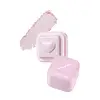What's inside
What's inside
 Key Ingredients
Key Ingredients

 Benefits
Benefits

 Concerns
Concerns

 Ingredients Side-by-side
Ingredients Side-by-side

Mica
Cosmetic ColorantSynthetic Fluorphlogopite
Titanium Dioxide
Cosmetic ColorantCetearyl Ethylhexanoate
EmollientPentylene Glycol
Skin ConditioningTriethoxycaprylylsilane
Silica
AbrasiveGlycerin
HumectantGellan Gum
Squalane
EmollientOctyldodecyl Stearoyl Stearate
EmollientHydrogenated Lecithin
EmulsifyingPolysorbate 80
EmulsifyingCaprylyl Glycol
EmollientGlyceryl Caprylate
EmollientChondrus Crispus Powder
AbrasiveTin Oxide
AbrasiveTocopherol
AntioxidantDisodium EDTA
CI 75470
Cosmetic ColorantMica, Synthetic Fluorphlogopite, Titanium Dioxide, Cetearyl Ethylhexanoate, Pentylene Glycol, Triethoxycaprylylsilane, Silica, Glycerin, Gellan Gum, Squalane, Octyldodecyl Stearoyl Stearate, Hydrogenated Lecithin, Polysorbate 80, Caprylyl Glycol, Glyceryl Caprylate, Chondrus Crispus Powder, Tin Oxide, Tocopherol, Disodium EDTA, CI 75470
Water
Skin ConditioningHydrogenated Didecene
Skin ConditioningIsododecane
EmollientMica
Cosmetic ColorantGlycerin
HumectantPropanediol
SolventCetyl PEG/PPG-10/1 Dimethicone
EmulsifyingSilica
AbrasiveSodium Chloride
MaskingHydrogenated Styrene/Isoprene Copolymer
Hydroxyacetophenone
AntioxidantPolyglyceryl-4 Isostearate
Emulsifying1,2-Hexanediol
Skin ConditioningCaprylyl Glycol
EmollientTriethoxycaprylylsilane
Trisodium Ethylenediamine Disuccinate
Pentaerythrityl Tetra-Di-T-Butyl Hydroxyhydrocinnamate
AntioxidantLindera Strychnifolia Root Extract
Skin ConditioningPhenoxyethanol
PreservativeEthylhexylglycerin
Skin ConditioningCI 77891
Cosmetic ColorantCI 77491
Cosmetic ColorantCI 45405
Cosmetic ColorantWater, Hydrogenated Didecene, Isododecane, Mica, Glycerin, Propanediol, Cetyl PEG/PPG-10/1 Dimethicone, Silica, Sodium Chloride, Hydrogenated Styrene/Isoprene Copolymer, Hydroxyacetophenone, Polyglyceryl-4 Isostearate, 1,2-Hexanediol, Caprylyl Glycol, Triethoxycaprylylsilane, Trisodium Ethylenediamine Disuccinate, Pentaerythrityl Tetra-Di-T-Butyl Hydroxyhydrocinnamate, Lindera Strychnifolia Root Extract, Phenoxyethanol, Ethylhexylglycerin, CI 77891, CI 77491, CI 45405
 Reviews
Reviews

Ingredients Explained
These ingredients are found in both products.
Ingredients higher up in an ingredient list are typically present in a larger amount.
Caprylyl Glycol is a humectant and emollient, meaning it attracts and preserves moisture.
It is a common ingredient in many products, especially those designed to hydrate skin. The primary benefits are retaining moisture, skin softening, and promoting a healthy skin barrier.
Though Caprylyl Glycol is an alcohol derived from fatty acids, it is not the kind that can dry out skin.
This ingredient is also used as a preservative to extend the life of products. It has slight antimicrobial properties.
Learn more about Caprylyl GlycolGlycerin is already naturally found in your skin. It helps moisturize and protect your skin.
A study from 2016 found glycerin to be more effective as a humectant than AHAs and hyaluronic acid.
As a humectant, it helps the skin stay hydrated by pulling moisture to your skin. The low molecular weight of glycerin allows it to pull moisture into the deeper layers of your skin.
Hydrated skin improves your skin barrier; Your skin barrier helps protect against irritants and bacteria.
Glycerin has also been found to have antimicrobial and antiviral properties. Due to these properties, glycerin is often used in wound and burn treatments.
In cosmetics, glycerin is usually derived from plants such as soybean or palm. However, it can also be sourced from animals, such as tallow or animal fat.
This ingredient is organic, colorless, odorless, and non-toxic.
Glycerin is the name for this ingredient in American English. British English uses Glycerol/Glycerine.
Learn more about GlycerinMica is a naturally occurring mineral used to add shimmer and color in cosmetics. It can also help improve the texture of a product or give it an opaque, white/silver color.
Serecite is the name for very fine but ragged grains of mica.
This ingredient is often coated with metal oxides like titanium dioxide. Trace amounts of heavy metals may be found in mica, but these metals are not harmful in our personal products.
Mica has been used since prehistoric times throughout the world. Ancient Egyptian, Indian, Greek, Roman, Aztec, and Chinese civilizations have used mica.
Learn more about MicaSilica, also known as silicon dioxide, is a naturally occurring mineral. It is used as a fine, spherical, and porous powder in cosmetics.
Though it has exfoliant properties, the function of silica varies depending on the product.
The unique structure of silica enhances the spreadability and adds smoothness, making it a great texture enhancer.
It is also used as an active carrier, emulsifier, and mattifier due to its ability to absorb excess oil.
In some products, tiny microneedles called spicules are made from silica or hydrolyzed sponge. When you rub them in, they lightly polish away dead skin layers and enhance the penetration of active ingredients.
Learn more about SilicaTriethoxycaprylylsilane is a silicone used to bind and stabilize ingredients.
As an emulsifier, it helps prevent ingredients from separating. This can help elongate the shelf life of products.
Triethoxycaprylylsilane is often used to coat mineral sunscreens ingredients to help give a better feel. It also helps reduce oxidative stress in sunscreens.
Learn more about Triethoxycaprylylsilane